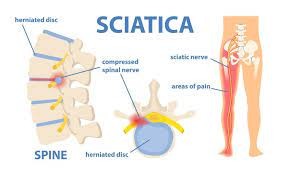Sciatica - Risks, Types and Treatment - Maximed Turkey

What Is Sciatica?
It is a nerve problem that involves the lower part of
the spinal cord, which is located between the lumbar vertebrae. It can also
affect other parts of the body. Blunt trauma to this area may lead to damage in
the sciatic nerve, resulting in sciatica.
You will experience pain on one or both sides of your
lower back and thigh when walking or doing any activity that requires you to
move your legs forward and backward, such as walking fast on uneven ground,
running, playing sports.
Other common symptoms are numbness or tingling
sensations in your foot or toes when walking on them for more than 10 minutes
at a time.
Why Is Sciatica Not Painful At First?
You may not feel intense pain because the nerve root is
compressed, which causes it to be like a water balloon in the nerves of the
lower part of the spine. As time passes, the nerve root starts to swell or get
inflamed. This causes intense pain that is worse when you stand up after
sitting for long periods.
When Does Sciatica Become Chronic?
Chronic sciatica lasts for several months to more than
6 months. It causes serious pain that is not relieved by taking medication.
Most people with this problem will have some type of nerve damage, which can
lead to permanent disability.
This is more common in older adults but can affect all
age groups.
What Are The Different Types Of Sciatica?
Sciatica has 2 main types of pain: Lumbar or lower back
pain occurs when the problem affects the nerve roots at the bottom of the
spinal cord, which are located between lumbar vertebrae Lumbar radiculopathy
happens when there is a problem with one or several nerve roots that connect
the spinal cord to muscles and other nerves in your legs and feet.
Who Is At Risk For Getting Sciatica?
Problems in the spine can lead to sciatica, such as
Wear and tear of the spinal cord as you age Degenerative disc disease (spinal
discs deteriorate as you age) Spinal stenosis (the spinal canal or opening that
surrounds the spinal cord narrows or shrinks) Herniated discs (discs bulge or
rupture)
How Is Sciatica Treated?
Some people recover fully after a few weeks to several
months. But if the problem doesn't go away after a few days, your doctor can
recommend treatment. Your doctor will take into consideration your pain severity
and whether it affects your ability to do daily tasks. Treatments to relieve
sciatica include:
·
Self-care measures: You can do things to reduce
pain and improve your mobility. You can take over-the-counter pain medications.
Ask your doctor which medications are best for you. Nonsteroidal
anti-inflammatory drugs (NSAIDs) such as ibuprofen or naproxen may help with
inflammation in the area.
Your doctor may recommend stretching exercises to help
reduce the severity of your pain and improve your range of motion if needed. If
you have chronic sciatica, it may be helpful to strengthen the muscles in your
legs by doing leg exercises three times a week, especially if you have weak or
tight hamstrings or hip flexors. Your doctor may recommend physical therapy.
·
Surgery: If self-care measures don't work, your
doctor may recommend surgery. It may be used to treat chronic sciatica that
doesn't respond to other treatments. Sciatic nerve blocks are sometimes given
to temporarily numb the damaged nerve roots.
Surgery can help relieve pain and improve your
mobility if you have lumbar disc disease or lumbar stenosis or if you have
spinal stenosis or herniation. However, there are risks with surgery so you
must talk with your doctor before having surgery for sciatica (see the
"Risks of surgery" section below).
Frequently Asked Questions Sciatica
What Causes Sciatica?
The most common cause of sciatica is a herniated disc,
although it can also result from spinal stenosis (the narrowing of the spinal
canal) or degenerative disc disease (deterioration of the discs that act as
shock absorbers in your spine). Other causes may include spinal fractures or
tumors.
How Is Sciatica Treated?
Treatment for sciatica depends on its cause. If there
is no serious nerve damage, it may go away on its own after several weeks to
several months. If you have inflammation in your spine resulting from an infection,
you may need antibiotics.
If nerve root damage is severe, surgery may be recommended. Surgery can also be used to treat chronic sciatica in some cases.
Is There A Cure For Sciatica?
There is no permanent cure for sciatica, but treatment
may help make the pain less severe or improve your mobility.
Are There Risks With Surgery For Sciatica?
If you have chronic sciatica that is not responding to
self-care measures, your doctor may recommend surgery to remove the damaged
nerve roots or lumbar disc or relieve pressure on them by removing part of your
spine.
